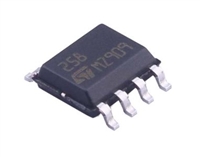| 是否无铅: | 含铅 | 是否Rohs认证: | 符合 |
| 生命周期: | Active | 零件包装代码: | TSSOP |
| 包装说明: | TSSOP, TSSOP10,.19,20 | 针数: | 10 |
| Reach Compliance Code: | compliant | ECCN代码: | EAR99 |
| HTS代码: | 8542.31.00.01 | 风险等级: | 1.47 |
| Samacsys Confidence: | 3 | Samacsys Status: | Released |
| 2D Presentation: | https://componentsearchengine.com/2D/0T/5501.2.1.png | Schematic Symbol: | https://componentsearchengine.com/symbol.php?partID=5501 |
| PCB Footprint: | https://componentsearchengine.com/footprint.php?partID=5501 | 3D View: | https://componentsearchengine.com/viewer/3D.php?partID=5501 |
| Samacsys PartID: | 5501 | Samacsys Image: | https://componentsearchengine.com/Images/9/AD8253ARMZ.jpg |
| Samacsys Thumbnail Image: | https://componentsearchengine.com/Thumbnails/2/AD8253ARMZ.jpg | Samacsys Pin Count: | 10 |
| Samacsys Part Category: | Integrated Circuit | Samacsys Package Category: | Small Outline Packages |
| Samacsys Footprint Name: | RM-10(MSOP) | Samacsys Released Date: | 2015-04-16 09:48:08 |
| Is Samacsys: | N | 放大器类型: | INSTRUMENTATION AMPLIFIER |
| 最大平均偏置电流 (IIB): | 0.04 µA | 标称带宽 (3dB): | 10 MHz |
| 最大输入失调电流 (IIO): | 0.03 µA | JESD-30 代码: | S-PDSO-G10 |
| JESD-609代码: | e4 | 长度: | 3 mm |
| 湿度敏感等级: | 1 | 负供电电压上限: | -17 V |
| 标称负供电电压 (Vsup): | -15 V | 功能数量: | 1 |
| 端子数量: | 10 | 最高工作温度: | 85 °C |
| 最低工作温度: | -40 °C | 封装主体材料: | PLASTIC/EPOXY |
| 封装代码: | TSSOP | 封装等效代码: | TSSOP10,.19,20 |
| 封装形状: | SQUARE | 封装形式: | SMALL OUTLINE, THIN PROFILE, SHRINK PITCH |
| 峰值回流温度(摄氏度): | 260 | 电源: | +-5/+-15 V |
| 认证状态: | Not Qualified | 座面最大高度: | 1.1 mm |
| 标称压摆率: | 25 V/us | 子类别: | Instrumentation Amplifier |
| 最大压摆率: | 4.5 mA | 供电电压上限: | 17 V |
| 标称供电电压 (Vsup): | 15 V | 表面贴装: | YES |
| 技术: | CMOS | 温度等级: | INDUSTRIAL |
| 端子面层: | Nickel/Palladium/Gold (Ni/Pd/Au) | 端子形式: | GULL WING |
| 端子节距: | 0.5 mm | 端子位置: | DUAL |
| 处于峰值回流温度下的最长时间: | 30 | 最大电压增益: | 1000 |
| 最小电压增益: | 1 | 标称电压增益: | 10 |
| 宽度: | 3 mm | Base Number Matches: | 1 |
| 型号 | 品牌 | 描述 | 获取价格 | 数据表 |
| AD8253_08 | ADI | 10 MHz, 20 V/レs, G = 1, 10, 100, 1000 iCMOS P |
获取价格 |

|
| AD8253ARMZ | ADI | 10 MHz, 20 V/レs, G = 1, 10, 100, 1000 iCMOS P |
获取价格 |

|
| AD8253ARMZ1 | ADI | 10 MHz, 20 V/レs, G = 1, 10, 100, 1000 i CMOS㈢ |
获取价格 |

|
| AD8253ARMZ-R7 | ADI | 10 MHz, 20 V/レs, G = 1, 10, 100, 1000 iCMOS P |
获取价格 |

|
| AD8253ARMZ-R71 | ADI | 10 MHz, 20 V/レs, G = 1, 10, 100, 1000 i CMOS㈢ |
获取价格 |

|
| AD8253ARMZ-RL | ADI | 10 MHz, 20 V/レs, G = 1, 10, 100, 1000 iCMOS P |
获取价格 |

|
 VIPER22A的资料手册解读、引脚参数说明、代换型号推荐
VIPER22A的资料手册解读、引脚参数说明、代换型号推荐

 ADS1256的资料手册解读、采集电压范围、读数变化原因分析及实际测量遇到的问题
ADS1256的资料手册解读、采集电压范围、读数变化原因分析及实际测量遇到的问题

 MAX6675资料手册参数详解、引脚配置说明
MAX6675资料手册参数详解、引脚配置说明

 LM258引脚图及功能介绍、主要参数分析
LM258引脚图及功能介绍、主要参数分析
